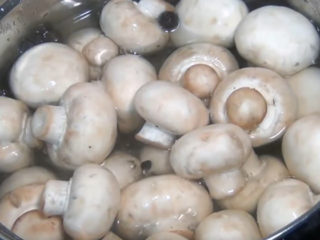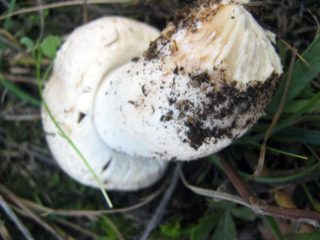Content
Royal champignons are one of the varieties of the large Champignon family. These mushrooms belong to the Lamellar category; they are humic saprotrophs. Another name for the species is two-spored, royal, brown champignon. In official sources it is found as Agaricus bisporus.
What do royal champignon mushrooms look like?
The fruit body shape of this species is classic. As can be seen in the photo, the two-spore champignon has a hemispherical cap shape. It is slightly depressed, and the edges are turned inward. Its diameter reaches 7-15 cm, but there are also giant specimens - 25-30 cm. There are remains of a bedspread along the edge. The surface of the cap is finely scaly or fibrous.
The flesh of royal champignons is dense, fleshy, with a pleasant mushroom smell. Its hue is whitish, but when cut, a slight pinkish tint appears.
In young specimens, the hymenophores are covered with a dense light film. As the mushroom matures, it breaks and forms a ring on the stalk. On the reverse side of the cap there are frequent free plates. Initially they have a gray-pink color, and then acquire a dark brown tint with a purple tint.
The leg of this species is thick and fleshy. Its length ranges from 3 to 8 cm, and its cross-sectional diameter is 1-3 cm. The lower part is cylindrical, narrowed at the base in some specimens. The surface is smooth, and its shade is identical to the cap. In this case, the presence of brownish spots is allowed. At the top of the leg there is a light wide ring.
How do brown champignons differ from white ones?
There are certain differences between royal champignons and ordinary ones. Thanks to this, it is impossible to confuse them.
The main characteristics of royal champignons:
- large size of the fruiting body;
- brown color of the cap;
- rich mushroom smell.
In addition, the price of royal champignons is significantly higher than that of ordinary white-capped mushrooms.
Where do brown mushrooms grow?
This species prefers to grow in open clearings directly on the soil. It can be found in gardens, vegetable gardens, park areas, ditches, greenhouses and on the side of roads. In areas where there is little grass, this variety practically does not grow. It is also rarely found in the forest.
The representative is distributed in many countries of the world and is cultivated artificially on an industrial scale. If desired, you can grow royal champignons yourself, creating favorable conditions for their growth.
Is it possible to eat champignons with a brown cap?
The two-spore champignon is classified as an edible species. Its taste is significantly higher than that of other relatives of this family. Therefore, it is classified in the second category.
Positive properties of the mushroom:
- improves the functioning of the digestive system;
- has a beneficial effect on brain activity;
- reduces the likelihood of blood clots;
- slows down the aging process;
- removes toxins from the body.
Royal champignons are characterized by a high content of chitin in the pulp, which makes the product difficult to digest. Therefore, it is not recommended to give royal champignons to children under 12 years of age, and they should not be consumed by people suffering from chronic diseases of the digestive system.
False look-alikes of brown king mushrooms
In terms of its external characteristics, this species is similar to the yellow-skinned champignon (Agaricus xanthodermus).Therefore, you need to learn to distinguish it from its poisonous relative, so as not to cause harm to health.
A characteristic feature of the double is the dark circle in the center of the cap, which clearly stands out against the background of the main tone. In addition, when pressed, the flesh turns yellow, and then turns orange and only subsequently brown.
When broken, the flesh of the false champignon emits a strong smell of disinfectant. Also, during cooking, the liquid turns yellow.
The fruiting period of yellow-skinned champignons begins in mid-July. They can be found in deciduous forests and mixed plantings, as well as in a park or garden.
Rules for collection and use
Mushrooms should be collected using a sharp knife, cutting them off at the base. This will preserve the integrity of the mycelium. When harvesting, it is necessary to give preference to young specimens, since their flesh is more tender and the mushroom smell is richer.
Before use, royal champignons must be thoroughly cleaned of grass and soil. Then remove the film covering the plate and the outer skin of the cap. Finally, wash the mushrooms.
Growing Brown King Champignons
Anyone can grow brown-capped champignons at home. But this process is long, labor-intensive and requires certain knowledge.
To do this you will need:
- cool room;
- high humidity;
- high-quality mycelium;
- special substrate.
To prepare nutritious soil, you need to stock up on wheat or rye compost and horse manure.
To prepare about 300 kg of substrate you need to combine:
- 150 kg of straw;
- 150 kg of humus;
- 2 kg of urea;
- 7 kg of gypsum;
- 5 kg chalk;
- 2 kg of superphosphate.
Before laying, the straw should be soaked in water for 24 hours. After this, lay it in layers, alternating with manure, and also alternately add other components.
The mycelium should be spread out in handfuls to a depth of 5-7 cm in a checkerboard pattern. The distance between the holes should be within 25 cm. Cover the top with a layer of substrate 5 cm thick. The first harvest can be harvested in four months.
Conclusion
Royal champignons stand out significantly from other edible relatives in taste and aroma. They are also used for medicinal purposes, to improve memory and mental abilities. But you need to consume mushrooms in moderation, since any excess leads to disruption of the functioning of internal organs.











